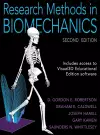
Research Methods in Biomechanics
5 authors - Hardback
£89.00
D. Gordon E. Robertson, PhD, an emeritus professor and a fellow of the Canadian Society for Biomechanics, wrote Introduction to Biomechanics for Human Motion Analysis. He taught undergraduate- and graduate-level biomechanics at the University of Ottawa and previously at the University of British Columbia, Canada. He conducts research on human locomotion and athletic activities and authors the analogue data analysis software BioProc3.
Graham E. Caldwell, PhD, an associate professor and a fellow of the Canadian Society for Biomechanics, teaches undergraduate- and graduate-level biomechanics at the University of Massachusetts at Amherst and previously held a similar faculty position at the University of Maryland. He won the Canadian Society for Biomechanics New Investigator Award and in 1998 won the Outstanding Teacher Award for the School of Public Health and Health Sciences at the University of Massachusetts at Amherst. He served as an associate editor for Medicine and Science in Sports and Exercise.
Joseph Hamill, PhD, is a professor and fellow of the Research Consortium, International Society of Biomechanics in Sports, Canadian Society for Biomechanics, American College of Sports Medicine, and National Academy of Kinesiology. He coauthored the popular undergraduate textbook Biomechanical Basis of Human Movement. He teaches undergraduate- and graduate-level biomechanics and is director of the Biomechanics Laboratory at the University of Massachusetts at Amherst. He serves on the editorial boards of several prestigious professional journals. He is adjunct professor at the University of Edinburgh in Scotland and the University of Limerick in Ireland and a distinguished research professor at Republic Polytechnic in Singapore.
Gary Kamen, PhD, is a professor and fellow of the American Alliance for Health, Physical Education, Recreation and Dance; American College of Sports Medicine; and National Academy of Kinesiology. He authored an undergraduate textbook on kinesiology, Foundations of Exercise Science, as well as a primer on electromyography, Essentials of Electromyography. He was president of the Research Consortium of AAPHERD and teaches undergraduate and graduate courses in exercise neuroscience and motor control in the department of kinesiology at the University of Massachusetts at Amherst.
Saunders (Sandy) N. Whittlesey, PhD, a graduate of the University of Massachusetts at Amherst, is a self-employed technology consultant specializing in athletic training, sporting goods, and clinical applications.
Additional Contributors
Norma Coffey, PhD, a postdoctoral researcher in statistics at the National University of Ireland at Galway, has expertise is functional data analysis and worked extensively with the Biomechanics Research Unit at the University of Limerick. Her current area of research involves applying functional data analysis techniques to time-course gene expression data.
Timothy R. Derrick, PhD, a professor in the department of kinesiology at Iowa State University, has an extensive background in signal processing and conducts research on impacts to the human body particularly from the ground during running activities.
Kevin Deluzio, PhD, is a professor in the department of mechanical and materials engineering at Queen's UUniversity in Kingston, Canada, and held a similar position at Dalhousie University. He studies human locomotion to investigate the biomechanical factors of musculoskeletal diseases such as knee osteoarthritis. He is also interested in the design and evaluation of noninvasive therapies as well as surgical treatments such as total-knee replacement.
Andrew (Drew) J. Harrison, PhD, is a senior lecturer in biomechanics in the department of physical education and sport sciences at the University of Limerick in Ireland and a fellow of the International Society for Biomechanics in Sport. He is the director of the Biomechanics Research Unit at the University of Limerick. His research focuses on biomechanics of sport performance and sport injuries.
Thomas M. Kepple, PhD, is an instructor in the department of health, nutrition, and exercise sciences at the University of Delaware. He worked for many years as a biomechanist at the National Institutes of Health on motion capture technology and gait laboratory instrumentation.
Ross H. Miller, PhD, an assistant professor in the department of kinesiology at the University of Maryland, has published papers on static optimization and forward dynamics as well as methods on nonlinear techniques of data analysis.
Scott Selbie, PhD, is an adjunct professor at Queen's University, Canada, and at the University of Massachusetts at Amherst. He is a graduate of Simon Fraser University, Canada. He is the director of research at C-Motion, developers of the Visual3D software, and president of HAS-Motion in Canada.
Brian R. Umberger, PhD, is an associate professor teaching biomechanics at the undergraduate and graduate levels in the department of kinesiology at the University of Massachusetts at Amherst. In 2010, he received the Outstanding Teacher Award for the School of Public Health and Health Sciences at the University of Massachusetts at Amherst. In his research, he uses a combination of experimental, modeling, and simulation approaches to study the biomechanics and energetics of human locomotion.
Richard E.A. van Emmerik, PhD, is a professor in the kinesiology department at the University of Massachusetts at Amherst, where he teaches motor control at the undergraduate and graduate levels. In his research, he applies principles from complex and nonlinear dynamical systems to the study of posture and locomotion.